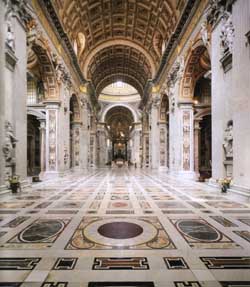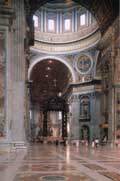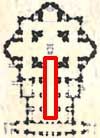|
||||

|
The red porphyry disc at the entrance, taken from the old basilica, is the stone on which Charlemagne and other Emperors were crowned. The
measurements of the largest churches in the
world are recorded in brass letters on the center of the floor.
The statues on the side pillars are among the 39 in the basilica of saints that founded religious orders. For complete list see: Founder Saints |
Letters on the South
(Left) Wall of the Nave from Lk 22:32:
"I have prayed for you Peter, that your faith may never fail;
and you in turn must strengthen your brothers"

Statues of Virtues:
1.Ecclesiastical Authority;
2. Divine Justice; 3.
Virginity; 4. Obedience;
5. Humility;
6. Patience; 7. Justice;
8. Fortitude
 
|

|
 |
|
The
Measurements of the Basilica
- from Guide to St Peter's Basilica, © 2003
From: Catholic
Encyclopedia Height of the
Nave Width of Nave Length of Transepts Length of Basilica
including vestibule Height from
pavement at Confession to the oculus of Lantern To summit of
cross surmounting the Lantern The measurements of the interior diameter of the dome vary somewhat, being generally computed at 137.7 ft, thus exceeding the dome of the Pantheon by a span of 4.9 ft. The surface
area of St Peter's is 163,182,2 sq ft.
|
Letters on the
North (Right) Wall of the Nave from Mt. 16:19
"I will entrust to you the keys of the kingdom of heaven. Whatever you
declare bound on earth shall be bound in heaven; and whatever you declare
loosed on earth shall be loosed in heaven"

Statues of Virtus:
9. Charity; 10. Faith;
11. Innocence; 12. Peace;
13. Clemency; 14. Constancy;
15. Mercy; 16. Fortitude
From: 'St. Peter's - Guide to the Basilica and Square'
In this nave seats were installed for the Council Fathers who celebrated
the Second Vatican Ecumenical Council here from 1962 to 1965. As for as
the third pilaster it was built by Carlo Maderno. It is 45 m. high (137
beneath the dome) 27 m. wide (140 m. in the transept) and 187 m. long.
It is bordered by three couples of massive pilasters, with Corinthian
pilaster strips. Above the pilasters are six arches (three on each side)
which support the long trabeation under the barrel vault enhanced with
late 18th-century coffers during the pontificate of Pope Pius VI.
On the trabeation which extends the whole length of the basilica is a Latin text in large black letters on a gold background. On the left, starting from the back it reads: "Ego rogavi pro te, o Petre, ut non deficiat fides tua: et tu aliquando converses confirma fraters tuos" ("I have prayed for you Peter, that your faith may never fail; and you in turn must strengthen your brothers" Lk 22:32). On the right, starting above the statue of St. Peter and extending to the back wall,are the words: "Quodcumque ligaveris super terram, erit ligatum etin coelis: et quodcumque solveris super terram, erit solutum et in coelis" ("I will entrust to you the keys of the kingdom of heaven. Whatever you declare bound on earth shall be bound in heaven; and whatever you declare loosed on earth shall be loosed in heaven." Mt 16:19).
At the beginning of the central nave the visitors' gaze is attracted to two holy water stoups that provide a clue to the basilica's real size: the cupids which seem small are in fact 2 m. tall. The basins containing the holy water are the work of Francesco Moderati (1680-1721) and A. Cornacchini (1685-1740), (on the left); and by Giuseppe Lironi (1668-1749) and G. B. De Rossi (on the right). They offer the holy water so that those who enter may make the sign of the cross, in memory of their own baptism.
Close to the entrance to this nave a great disc of red porphyry stands out against the marble paving. It comes from the old basilica, where it was located near the main altar. Kneeling on it, the Emperor Charlemagne was crowned Emperor by Pope Leo III, at Christmas in the year 800. Another 21 emperors subsequently knelt on this same disc to receive the crown of the Holy Roman Empire from the Pope's hands.
As they proceed, visitors are curious to observe the measurements of the 15 largest churches in the world recorded in brass letters on the pavement. Toward the center of the nave, the Holy Year of the Redemption proclaimed by Pius XI in 1933 is also recalled by an inscription on the floor.
The nave was decorated by Gian Lorenzo Bernini, who was commissioned by Innocent X in 1645 to complete the decoration of the pilasters and chapels. He and his assistants are therefore responsible for the various decorations: the cherubs, the doves and the symbols of the papacy such as the tiara and the keys.
On the inner sides of the colossal pilasters, between the pilaster strips are two sequences of niches which contain 39 statues of the founders of religious orders and congregations, placed here as from the beginning of the 18th century. Many of their faces are familiar to us. They all remind us to live the Gospel and to follow Jesus. On the right, starting at entrance are: St. Theresa of Jesus (below) and St. Sofia Maddalena Barat (above), St. Vincent de Paul and St. John Eudes, St. Philip Neri and St. John Baptist de la Salle, St. John Bosco (above the statue of St. Peter). On the left are: St. Peter of Alcantara and St. Lucia Filippini, St. Camillo de Lellis, St. Louis Grignion de Montfort, St. Ignatius of Loyola, St. Anthony Mary Zaccaria, St. Francis de Paola, St. Peter Fourier. As we shall see later, the saints continue in the transept.
From: 'St. Peter's Basilica - A Virtual Tour' by Our
Sunday Visitor
When entering the Basilica, the feeling of admiration and astonishment
created by the grandeur of the interior and its decorations go beyond
all expectations, and such feelings are enhanced while moving slowly along
the central aisle, inevitably attracted first by the Canopy rising under
the extremely bright opening of the dome, and then by the Confession,
which is the epicenter of this Temple.
In reality, the vastness of the general architecture and its special elements is not immediately perceived, because all the decorations added to the bare wall structures, and completed by Maderno at the end of the 16th century, were executed gradually with a great unifying sense of proportions. This balance was initially imposed by Bernini's supervision in the 17th century: the second great master who, after Michelangelo, left the most significant influence on St. Peter's, with a talent in which the Baroque spirit of the century is personified but always with a "classical" respect for the previous architectural space.
In effect, in the 17th century and quite satisfactorily also in the next century, the decorations made in the central aisle were successfully harmonized with the majestic grandeur of the space and its supporting elements designed by Michelangelo, with what is at least a three-fold increase in normal human proportions.
To recognize this it is only necessary to move toward the two holy water fonts (stoups) which are located at the end of the first arcade and do not capture much attention from the entrance; but, upon closer inspection, display all their grandeur with their more than two-meter tall chubby angels. They were created from 1722 to 1725, based on designs by Cornacchini, while the Sienna yellow basins were created by Giuseppe Lironi and the previously mentioned putti by Francesco Moderati.
The
largest churches in the world as listed on the nave floor of St. Peter's.
1. TEMPLVM VATICANVM * M.186.36, (St
Peter's in the Vatican)
2. LONDINENSIS S.PAVLIS FANVUM * M.158.10,
(St Paul's, London, UK)
3. FLORENTINA METROPOLITANA * M.149.28,
(The Duomo, Florence, Italy)
4. ECCLESIA SS. CORDIS JESV
BRVXELLIS * M.140.94, (Sacred Heart of Jesus, Brussels, Belgium)
5. SANCTVARIVM IMMACOLATAE
CONCEPT. WASHINGTON * M.139.14,
(Immaculate Conception, Washington DC, USA)
6. ECCLESIA CATHEDRALIS RHEMENSIS
* M.138.69, (Rheims Cathedral, Rheims, France)
7. PRIMARIVM TEMPLVM MEDIOLEANENSE
* M.134.94, (The Duomo, Milan, Italy)
8. TEMPLVM CATHEDRALE COLONIENSE
* M.134.94, (Cologne Cathedral, Cologne, Germany)
9. ECCLESIAS CATHEDRALIS SPIRENSIS
* M.134, (Speyer Cathedral, Speyer, Germany)
10. BASILICA S. PETRONII BONONIAE
* M.132.54, (San Petronio, Bologna, Italy)
11. TEMPLVM METROP. HISPALEN SEVILLA
* M.132, (Seville Cathedral, Seville, Spain)
12. BASILICA METROP. B.M.V. PARISIEN
* M.130, (Notre Dame, Paris, France)
13. BASILICA S. PAVLI VIA
OSTIENSI * M.127.36, (St Paul's Outside the Walls, Rome, Italy)
14. ECCLESIA CATHEDRALIS S. VITI
PRAGAE * M.124, (St Vitus, Prague, Czech Republic)
15. PRIMITIALIS ECCLESIA TOLENTANA
- M.122, (Toledo Cathedral, Toledo, Spain)
16. S.S. ECCLESIA LATERANENSIS - M.121.84,
(St John Lateran, Rome, Italy)
17. ECCLESIA CATHEDRALIS
BVM ANGELORVM - M.120.62,
(Our Lady of
the Angels, Los Angeles, CA.)
18. ECCLESIA CATHEDRALIS METROPOLITANA
PLATENSIS - M.120,
(La Plata Cathedral, La Plata, Argentina)
19. ECCLESIA CATHEDRALIS METROPOLITANA
MEXICANA - M.119.55,
(Mexico City Cathedral, Mexico City, Mexico)
20. ECCLES. CATHED. B.M.V. ANTVERPIENSIS
- M.118.60,
(Antwerp Cathedral, Antwerp, Belgium)
21. ECCL. S. IVSTINAE V.M. PATAVIN
- M.118.50, (Santa Giustina, Padua, Italy)
22. BASILICA CATHEDRALIS
ESZTERGOM - M.118, (Esztergom Cathedral, Esztergom, Hungary)
23. ECCLESIA CATHEDRALIS
FERRARIENS - M.118, (Ferrara Cathedral, Ferrara, Italy)
24. BASILICA ASSISIEN. S.MARIAE
ANG. - M.114.76,
(Basilica of Santa Maria degli Angeli, Assisi, Italy)
25. BASILICA CATHEDRALIS
SYDNEYENSIS - M.114.61, (St Mary's Cathedral, Sydney)
26. CATH. METROP. SANCTI PAVLI
BRASILIA - M.111.45, (St Paul's, Brasilia, Brazil)
27. ECCLESIA CATHEDRALIS
WESTMONASTERIENSIS - M.110,
(Westminster Cathedral, London)
28. CONSTANTINOPOLITANA DIVAE
SOPHIAE ECCLESIA - M.109.57,
(Hagia Sophia, Istanbul, Turkey)
29. CATHEDRALIS SANCTA CRVCIS BOSTONIENSIS
- M.109.14,
(Cathedral of the Holy Cross, Boston, MA.)
30. BASILICA GEDANENSIS
BEATISSIMAE VIRGINIS MARIAE - M.103.50,
(Basilica of the Virgin Mary, Gdansk, Poland)
31. ECCLESIA METROPOL. S. PATRITII
NEO EBORACEN. M. 101.19,
(St Patrick's, New York, USA)
The Christian Emperors crowned in the Vatican Basilica
| 1. December 24, 800 | Charlemagne by Leo III |
| 2. April 5, 823 | Lothar I by St. Paschal I |
| 3. December 2, 850 | Ludovico II by St Leo IV |
| 4. December 25, 875 | Carlo il Calvo by John VIII |
| 5. December 25, 881 | Carlo il Grosso by John VIII |
| 6. February 21, 891 | Guido duke of Spoleto by Stephen V |
| 7. 895 | Arnolfo di Carinzia by Formosus |
| 8. February 901 | Ludovic III of Provence by Benedict IV |
| 9. March 24, 915 | Berengario duke of Friuli by John X |
| 10. February 2, 962 | Otto I the Great by John XII |
| 11. December 25, 967 | Otto II by John XIII |
| 12. May 21, 996 | Otto III by Gregory V |
| 13. February 14, 1014 | Henry II of Germany by Benedict VIII |
| 14. March 26, 1027 | Conrad II of Salico by John XIX |
| 15. December 25, 1046 | Henry III the Black by Clement II |
| 16. April 13, 1111 | Henry V by Paschal II |
| 17. June 18, 1155 | Federico I Barbarossa by Adrian IV |
| 18. April 15, 1191 | Henry VI by Celestine III |
| 19. October 4, 1209 | Otto IV by Innocent III |
| 20. November 22, 1220 | Federico II by Honorius III |
| 21. April 5, 1355 | Charles VI by Pietro Bertrand, bishop of Ostia on behalf of Innocent VI |
| 22. May 31, 1433 | Sigmund of Luxembourg by Eugenius IV |
| 23. March 19, 1452 | Federico III by Nicholas V |


